| Home | First Posted: Dec 2, 2009 Jan 21, 2020 | |
Viet Nam Tripby Debora JohnsonPicture Galleries: The Many Faces of Viet Nam
The horses in Viet Nam were small and came from Indo China stock. There is no breed in China known as the "Chinese Pony." A number of horses come from China and are as distinct as the Thoroughbred, the Quarter Horse, the Tennessee Walking Horse, etc. There are three types of breeds in China: native breeds, introduced breeds, and developed breeds. The types are Mongolian, Southwest, Hequ, Tibet, and Kazakh. Among these types there are over 30 different breeds in China now being imporoved all the time. All but one breed are considered horses. The only one considered a pony breed is the Guoxia. China has more than one sixth of the world's population of horses. The "Chinese Pony" is from the Mongolian and Asian Wild Horse. The Vietnamese use these small animals to pull carts and in the fields for hauling, as well. I did not see anyone riding these animals; however, I am told that they are ridden, as well. The horses came in a variety of colors. We saw gray as shown below, dun, buckskin and chestnut. There may be more colors but we did not see them. Thoroughbred horse racing is good sport in Viet Nam. Much of the thoroughbred stock is brought in from Australia and Europe. 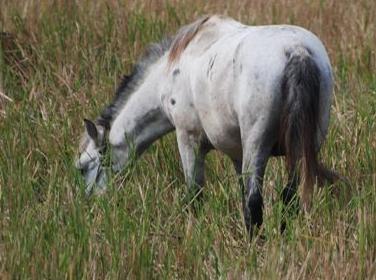 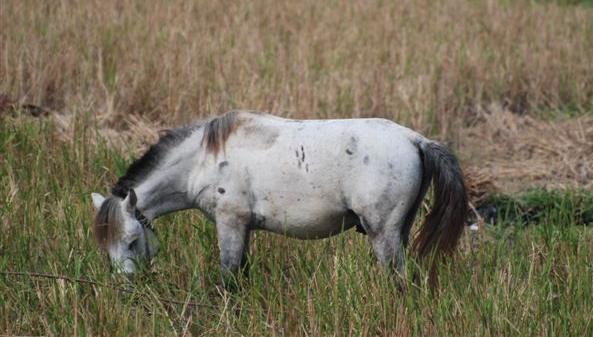 Viet Nam Horse in the field.
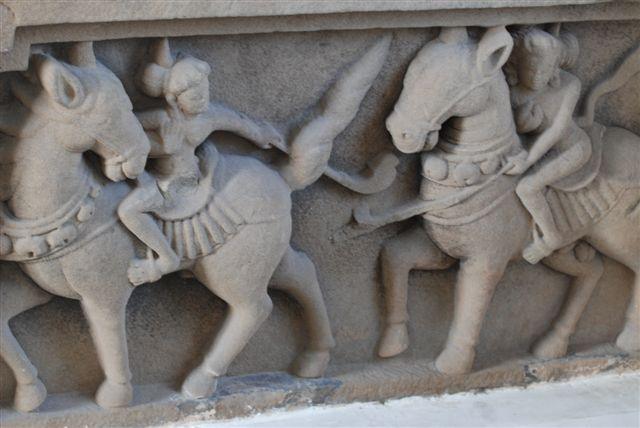 Vietnamese Horse Carving 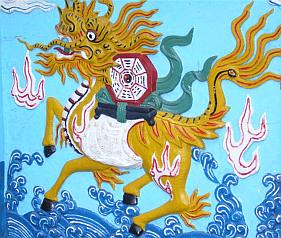 Horse Painting
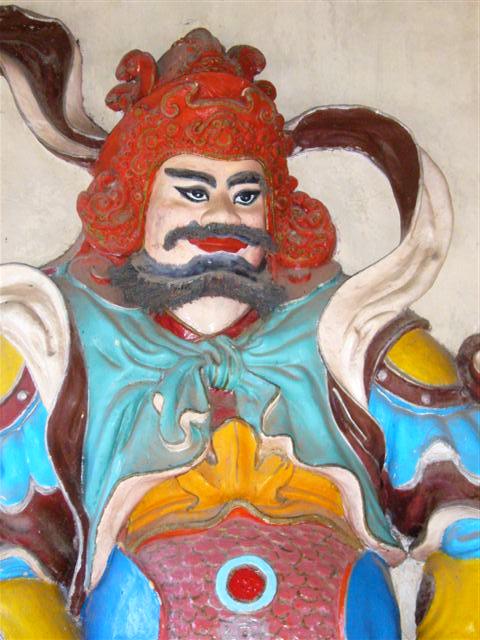 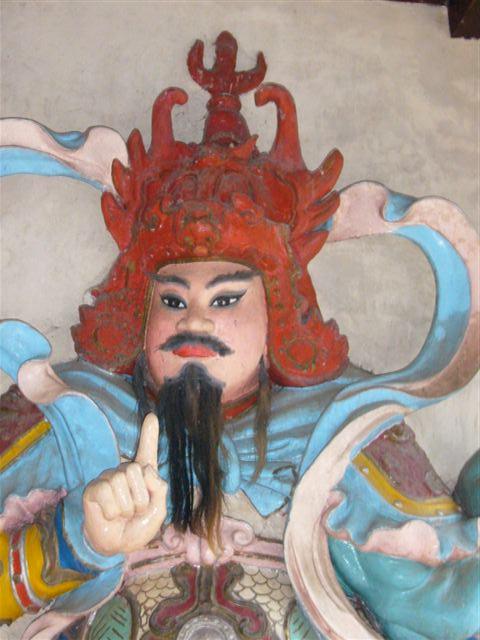 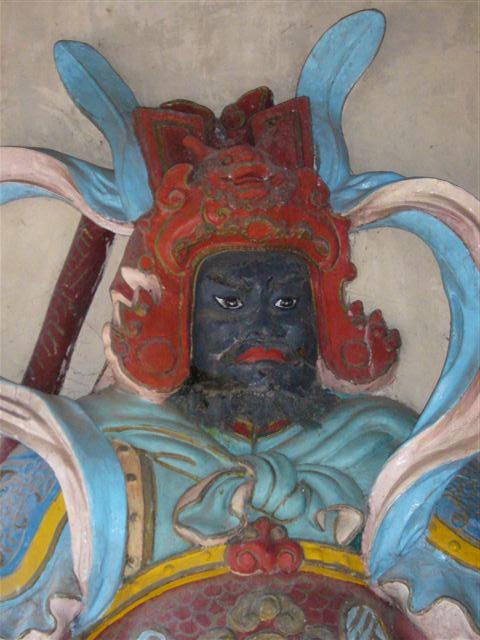 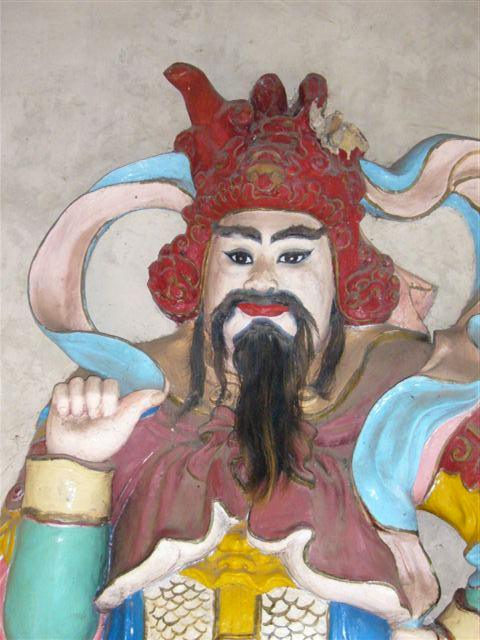 It generally takes two days to get to Viet Nam when you fly from New York. We changed planes in Taiwan and then flew on to Ho Chi Minh City. You cross the International Dateline and lose a day. But remember, you gain back that day upon your return. Itinerary
Ho Chi Minh City, Vietnam - Ho Chi Minh City (Saigon), Vietnam. Our hotel, Saigon Equatorial Hotel, was located in the heart of the city within easy access to shopping, touring and dining. We relaxed from the plane trip and just explored the city. Ho Chi Minh City & Cu Chi Tunnels. We drive to the Cu Chi Tunnels, begun by the Viet Minh in the 1940's. The incredible network of tunnels once stretched for 210 miles and contained extensive Viet Cong infrastructure including tactical quarters, storage rooms, kitchens, a school and even an underground hospital. Most entrances were so well disguised that only a small portion of the system was ever discovered during the war, despite the fact that some 125 miles ran under a U.S. military base.
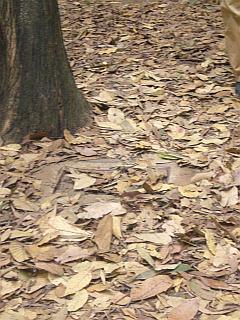  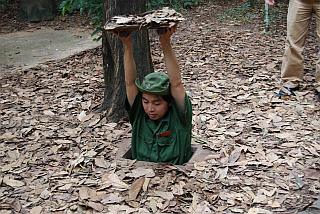 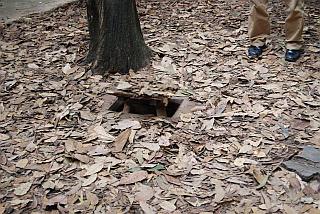  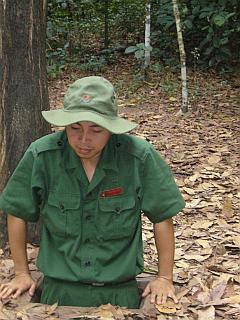 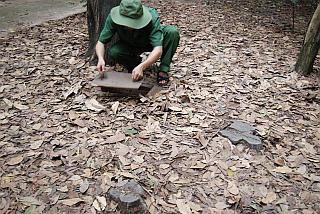 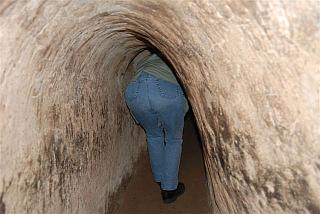 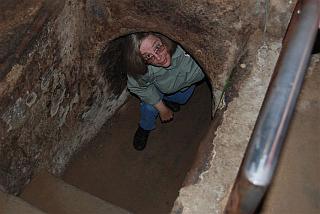 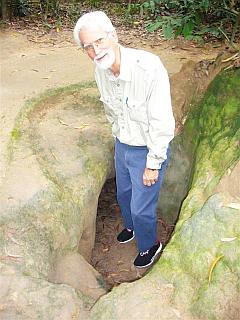 Torture Equipment and Traps
  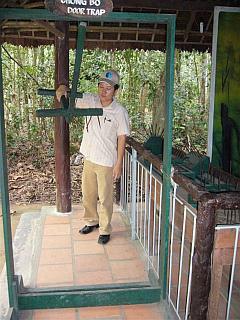 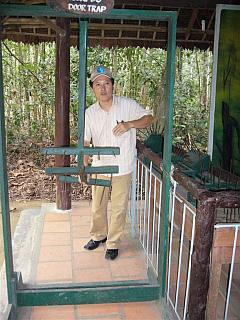 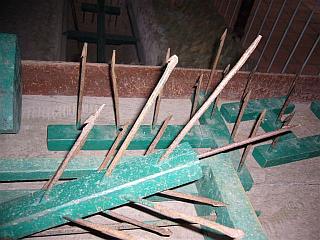 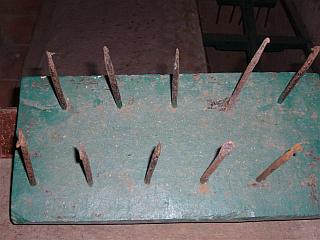 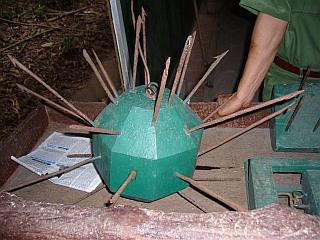 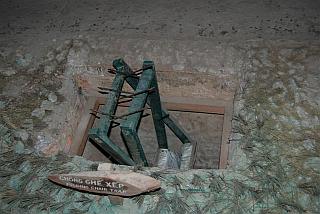 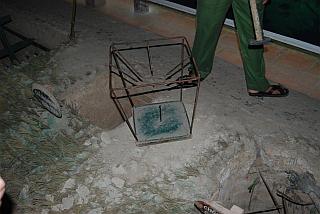 Thien Hau Pagoda, Saigon - Today we explored Ho Chi Minh City (still called Saigon by many locals), including the former Presidential Palace, Notre Dame Cathedral, Old Saigon Post Office and Thien Hau Pagoda in the city's bustling Chinatown. Floating Market, Mekong - Mekong Delta. We left for Cai Be, deep in the heart of the Mekong Delta. En route, we stopped at Cao Dai Temple to witness, firsthand, a fascinating fusion of Buddhism, Confucianism, Taoism, native Vietnamese spiritualism, Christianity and Islam. From there we continued on to Cai Be and embark on a private cruise to the colorful Cai Be floating market. We transferred to smaller boats for a ride through the beautiful canals of Tan Phong island, then enjoyed lunch at Anh Kiet ancient house. Continuing on by boat we visited a handicraft village to observe locals making rice-net for spring-rolls, fish sauce, cooking salt, and more and then returned to Ho Chi Minh City at the end of the day.
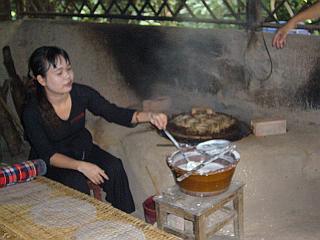 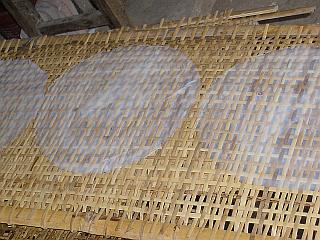 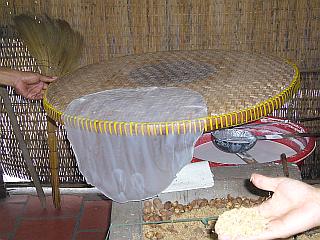  Making rice wraps
Ho Chi Minh City, Da Nang & Hoi An
Today we got in some shopping time, then transferred to the airport for our flight to Da Nang on the coast of the South China Sea.
Hoi An - An UNESCO World Heritage Site established in the 15th century, the ancient town of Hoi An was one of the most important trading ports in Southeast Asia and an important center of East-West cultural exchange. It is located 30 km south of Danang on an estuary of the Thu Bon River, the longest river in the province. Previously called Faifo, Hoi An has been shaped by many foreign influences over the centuries. Thankfully its ancient past is superbly preserved in a fascinating collection of temples, pagodas, shop houses and architecturally magnificent private homes which make up the town's old quarter. One of the town's landmarks is the bright red Japanese Bridge, a wooden structure originally built in 1593. Not far from the Museum of History and Culture is the Central Market selling everything from fruit and flowers to tailor-made clothes and bicycle tires. Hoi An is also famous for its wood carvings from Kim Bong village. By coach we were driven to Hoi An, on the banks of the Thu Bon River. The colorful market town of Hoi An is an exceptionally well-preserved example of a major Southeast Asian trading port from the 15th to the 19th centuries, with ships arriving from all over the world to obtain silk and other fabrics, sugar, tea and ceramics. Hoi An's traditional Vietnamese architecture has been preserved, and there are many historic temples and pagodas in the area. Japanese Bridge, Hoi An Old Town - At this destination you can have an entire wardrobe made within 24 hours. You might want to take advantage of Hoi An's world-famous tailors during your stay here. Anything you might want to wear can be made for you in Hoi An, all at bargain prices and with expert workmanship. Do NOT have your clothes made at the factory where the tour takes you. Their prices are up to 5 times higher than the tailors in the town. My husband had two blazer jackets made out of a fine wool fabric made in France. They were fully lines and cost $40.00 each. In the factory for the same fabric and lining the cost was $289.00. The guide gets up to 60% kickback from the factory and the prices are greatly inflated! We stayed in Hoi An Trails Resort which was a lovely accommodation. Trieu Châu Assembly Hall, Hoi An - This morning, we enjoyed a walking tour of this World Heritage Site. Along the way we visited the Japanese Covered Bridge which features a Buddhist pagoda attached to one side and the town's most famous landmark, a beautiful Chinese Assembly Hall built in 1740 as a meeting place for all Chinese residents of the town. The assembly hall was built by Chinese merchants to also worship the God of the oceans in the 19th century. This god protected sailors from the rough South China Sea. The hall is lavishly decorated with murals and a replica of a Chinese ship, and Phuoc Kien Pagoda, also called Kim Son Pagoda, built in 1697 by Chinese Phuoc Kien merchants at Hoi An. Outdoor Market, Vietnam - The Central Market is quite amazing. You will find everything from fruit and flowers to tailor-made clothes and silk lanterns, whose flexible bamboo frames are designed to collapse, so they are easily transported home as a souvenir. We had an excellent lunch then spent the afternoon at leisure. Bill and I purchased all our Christmas presents here. We also went wading in the China Sea. The water was wonderfully warm, maybe 68°F. Hoi An is famous for wood carvings. This is an excellent place to pick up that kind of treasure. Just don't buy it at the factories because of the enormous mark-up and guide kickbacks. You will see exactly the same wood carvings in the small market shops. You can haggle on price there is you choose but the starting price will be much less than at the factories. 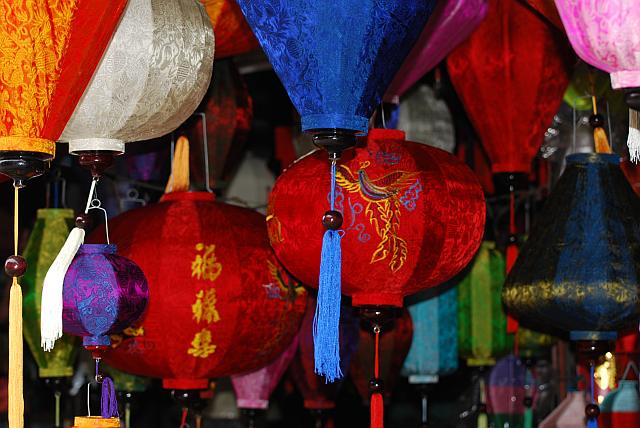 Silk Lanterns
Hindu temple complex at My Son - Today we took a half day trip to visit the capital and religious center of the former Champa Kingdom, My Son. Here, 40km southwest of Hoi An in a lush green valley, are dozens of red brick towers and sanctuaries dating from between the 7th and 13th centuries. Tra Kieu Cham Art - On the way back to Hoi An we stopped to visit Tra Kieu, formerly known as Simhapura or the Lion Citadel, the capital of Champa between the 4th and 8th centuries. Some of the finest sculpture in Da Nang's Cham Museum originated from here. Thuy Son Caves, Vietnam - Hoi An, Da Nang & Hue. This morning we were driven to the coastal city of Da Nang, one of Vietnam's most important ports. During the Vietnam War, Da Nang was home to a huge U.S. Air Force base. But it is best known for its impressive art and architecture from the Cham Dynasty, dating from the 4th to 14th centuries. South of Da Nang are the Marble Mountains, five marble hills representing the elements of the universe--water, wood, fire, metal and earth. One of the hills, Thuy Son, is honeycombed with caves containing Cham, Buddhist, and Confucian relics, pagodas, and temples. The Cham Museum here contains the finest collection of Cham sculptures in the world. We drove over the Hai Van Pass and enjoyed the spectacular views. China Beach is a former U.S. recreation base, known for its sparkling white sand and excellent views of the Marble Mountains.   China Beach
Emperor Khai Dinh's Mausoleum, Imperial City, Hue - Hue, is the former imperial capital of Vietnam, seat of the Nguyen Dynasty that ruled Vietnam between 1802 and 1945. We visited the walled Citadel containing the Imperial City, modeled on the Forbidden City of Beijing, and the Purple Forbidden City within, former home of the royal family. This great sprawling complex of temples, pavilions, moats, walls, gates, shops, museums and galleries is Hue's prime attraction. Thien Mu Pagoda from Perfume River - We took a boat trip on the Perfume River. It took us past Hue's best known religious site, the Thien Mu Pagoda. According to legend, an old woman appeared on a hill where the pagoda now sits and predicted that a great leader would one day build a pagoda in that spot in order to bring peace to the country. Lord Nguyen Hoang visited the area in 1601 and upon hearing of the legend, he ordered the pagoda built, naming it Chua Thien Mu, the Heavenly Lady Pagoda. Later we visited the popular Dong Ba Market, one of the must-see sites in Hue, where fruit, vegetables, fish, rice and other staples of the traditional Vietnamese diet are sold along with foods made from these ingredients. We dined at Y Thao Restaurant for dinner this evening and stayed at the Morin Hotel which was most enjoyable. Hoa Lo Prison, Hanoi, in 1993: Hue and Hanoi. We took a short flight to Hanoi then transferred to our hotel. Hanoi's rich history is closely tied to French colonialism as well as the Chinese era, both evident in the city's architecture, cuisine and culture. We visited the Maison Centrale, Hoa Lo Prison, also known as the Hanoi Hilton during the Vietnam War. Chauffeur Pedaled Cycle Ride
 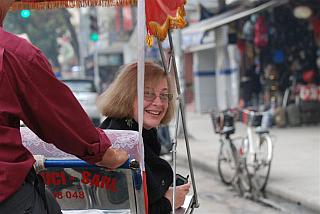 Chauffeur pedaled "cyclo," Vietnam - Make sure to take a tour by cyclo, a chauffeur-pedaled tricycle, through the city's Old Quarter, known as the 36 Streets. This bustling area of narrow streets is home to literally thousands of small businesses and shopkeepers. It is a great place to explore, especially by cyclo, with plenty of photo opportunities all around you. The group took this cycle trip for one hour around the city. A funny thing happened. Bill and I were grabbed by two drivers and put in their cycles immediately. Then the drivers began to talk among themselves in Vietnamese. I asked my driver what they were saying and he explained that they did not want to take the overweight people on our trip for one hour. I cannot say that I blame them. Below is a visual of some of the overweights, the loud and the ignorant. One of the ladies in the group did not know that the Taj Mahal was in India. Sad! I have deleted any identifying features to protect their identity, but you can see why the chauffeur-pedaled tricycle driver's were unhappy!
 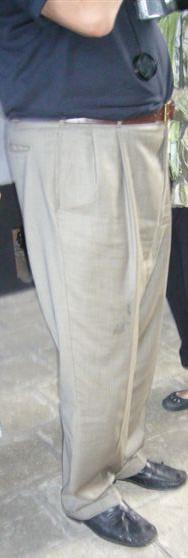 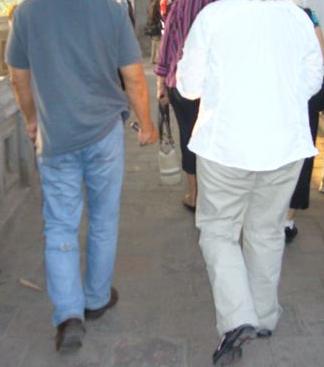 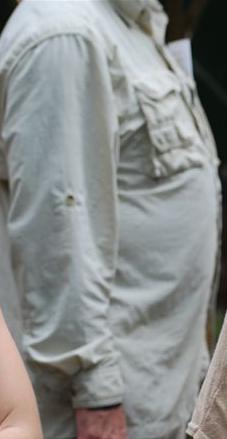 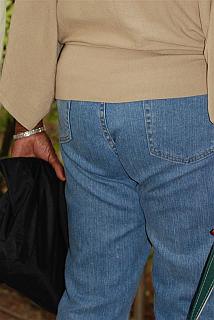 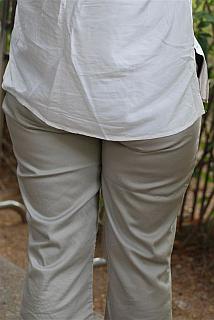  The ignorant, the loud and the heavy!
Water Puppet show in Hanoi - We enjoyed a unique theater, ancient form of Vietnamese entertainment known as Mua Roi Nuoc, or Water Puppets, where puppeteers control their puppets using long bamboo rods and string mechanisms hidden beneath the water's surface. Our hotel was the Melia Hanoi which was not great. The first day of arrival our room were upgraded to a suite which was lovely. Upon our return our room on the last two days was like a Days Inn with burn marks in the carpet and peeling stuff on the walls. However, the bed was clean and firm, the shower worked and we did not get any bed bugs! Breakfast was also a lovely buffet. Hanoi, Halong Bay and Emeraude Cruise - We were driven from Hanoi to Halong. This amazing bay, a UNESCO World Heritage site, is dotted with thousands of limestone karsts and isles. Local legend has it that long ago, when the Vietnamese were fighting Chinese invaders, the gods sent dragons to help defend the land. The dragons spit out jewels and jade, which turned into the islands and islets of Halong, forming a great wall against the invaders.
The Emeraude - We boarded the Emeraude, a wonderful replica of one of the classic steamships of the colonial era of French Indochina. There were Canadians, French, Americans, Brazilians and other countries represented among the visitors. With 36 luxurious air-conditioned cabins, a restaurant, two bars and a sun deck, this cruise was an enjoyable Halong Bay experience. The meals were buffet style, but good. Bill and I watched the sun set in a display of dashing colors. After that display we enjoyed a lovely dinner buffet. As usual we ate too much! The wonderful aroma of freshly brewed coffee filled the air the next morning. How lovely is that? We enjoyed a wonderful breakfast and returned to Tuan Chau quay. We disembarked the Emeraude and drove back to Hanoi by coach. The drive takes about 4 hours. We ate, shopped and explored side streets and alleys together. The Melia Hanoi was our hotel. It was adequate but not up to the scale of the others on this trip. 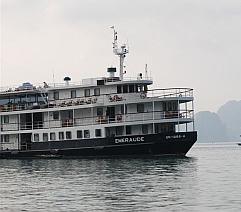 The Emeraude
Pictures of Halong Bay - UNESCO World Heritage site - dotted with thousands of limestone karsts, isles and caves.
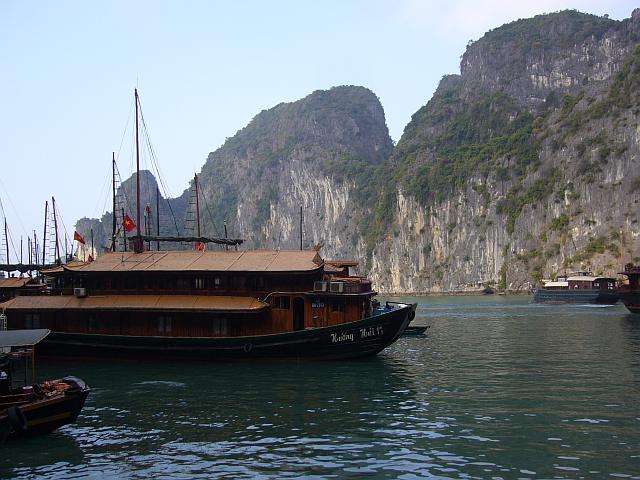 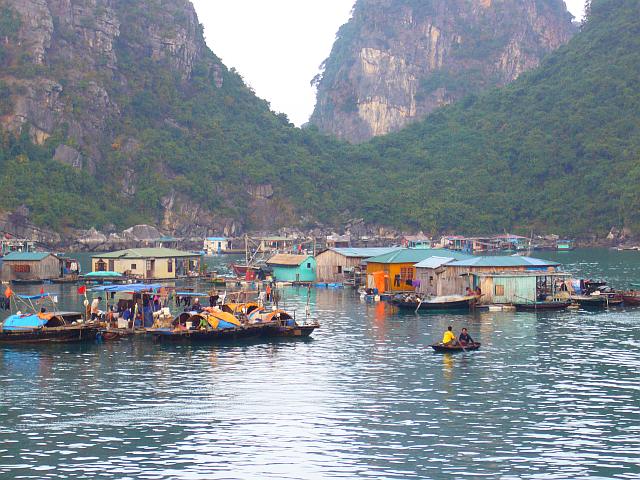 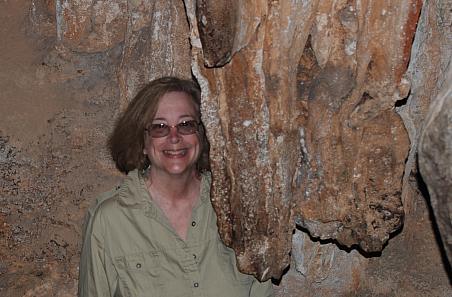 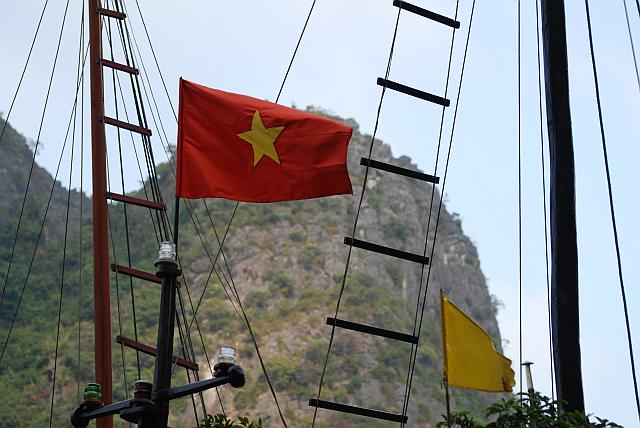 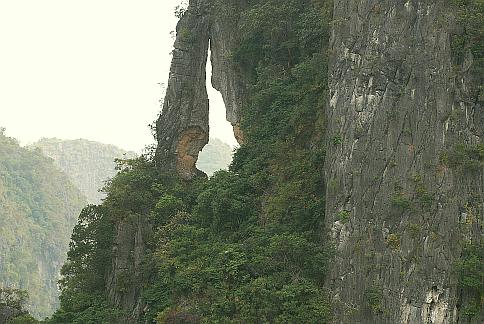 Ho Chi Minh Mausoleum, Hanoi This morning's we took a sightseeing tour to explore the highlights of Hanoi. We saw the Ho Chi Minh Mausoleum. Ho Chi Minh lies in state for all to see. Entry into his mausoleum has many rules and you are moved along at a quick rate. Other sites were his "house on stilts" where he resided during the later years of his life, one of the most important and visited sites in Vietnam. Next came the One Pillar Pagoda, built on stilts over a lake in 1049 by King Ly Thai Thong. A prayer is said to bring fertility and good health at this site. Temple of Literature, Hanoi -The Temple of Literature, Vietnam's first university constructed in 1070 by King Ly Thanh Tong, was constructed to pay tribute to education and to those of high academic achievement. Today, art students sit on the grass and try to reproduce the traditional Vietnamese architecture on paper while enjoying the beautiful and well-preserved gardens of this quiet retreat into Vietnamese educational history.Bill and I shopped today for last minute tourist trinkets to take home for presents. We had lunch, together, at the famous Metropole built by the French. We sat in the sun room which was absolutely beautiful and enjoyed a two hour lunch (Spices Garden Restaurant). It was just wonderful. This evening we returned to the Metropole to have an exquisite dinner (Le Beaulieu Restaurant)--it was one of the finest dining that we have had anywhere in the world. Bill and I would highly recommend it if you are going to Viet Nam. Make sure to make reservations. Bill had scallops for an appetizer, crackling pork belly for the entrée and a we shared a decadent dessert of chocolate and whipped cream. Some of the whipped cream was mixed with Pina Colada--boy was it good! I had guinea fowl Foie gras for my appetizer and a rack of lamb cooked medium rare for my entrée. Both were unbelievably delicious. LE BEAULIEU RESTAURANT SPICES GARDEN RESTAURANT Massage in Viet Nam - Warning or Heads Up! Massage is given all over Viet Nam, however, a word or warning if you are a male, a wife or a girlfriend: At the end of your body massage you may be asked (even in the 5* hotels) if you want a "happy ending" or "boom-boom." Just know that these are buzz words for sex. Language in Viet Nam The Vietnamese language is a tonal language. It is the most difficult tonal language and has the most tones-six. It should also be noted that Vietnamese uses only one syllable words. When you see Vietnam spelled as one word that is an American affectation. It is actually spelled Viet Nam. "...In East Asia, tone is typically lexical. This is characteristic of heavily tonal languages such as Chinese, Vietnamese, Thai, and Hmong. That is, tone is used to distinguish words which would otherwise be homonyms, rather than in the grammar, though some Yue Chinese dialects have minimal grammatical use of tone. However, in many African languages, especially in the Niger-Congo family, tone is crucial to the grammar, with relatively little lexical use. In the Kru languages, a combination of these patterns is found: nouns tend to have complex tone systems reminiscent of East Asia, but are not much affected by grammatical inflections, whereas verbs tend to have simple tone systems of the type more typical of Africa, which are inflected to indicate tense and mood, person, and polarity, so that tone may be the only distinguishing feature between 'you went' and 'I won't go'. In colloquial Yoruba, especially when spoken quickly, vowels may assimilate to each other, and consonants elide, so that much of the lexical and grammatical information is carried by tone. In languages of West Africa such as Yoruba, people may even communicate with so-called "talking drums," which are modulated to imitate the tones of the language, or by whistling the tones of speech..." A good example of the tonal language is the use of the word "ma." It has many meanings depending on where the tone or accent is placed. When verbalizing the word you must hear the intonation. When written, the different characters appear above or below the word. Those characters denote what tone, pitch or intonation to use.  Hanoi - We enjoyed a leisurely breakfast and then were taken to the airport for our flight home. I would like to note that China Airlines was clean, efficient, and had some leg room for my husband, Bill, who is 6' 2" They tried to accommodate the best that they could. Both directions the air flight was full! Half the leg was a Boeing 747 and the other half was an Airbus. For More Information: Bill and I read the book, Over the Moat, by James Sullivan. It is a true story and gives lots of insight into Viet Nam and the customs. We stayed in the Morin Hotel in Hue which is the setting of the book. That was really fun on the trip to see the actual places referenced in the story.Silk Making My Son Sanctuary Viet Nam The Boy Racers of Saigon The Bach Ma Temple Horse Racing in Ho Chi Minh City Bet Your Dong at the Saigon Horse Races - HCMC - Vietnam |